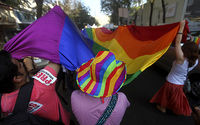by Marc Montgomery
 Dealing with being gay can be difficult for most people, but adding an ethnic background to the mix can make things even more colourful and, some artists argue, be good for one’s creative juices.
Dealing with being gay can be difficult for most people, but adding an ethnic background to the mix can make things even more colourful and, some artists argue, be good for one’s creative juices.
A discussion panel taking place on March 1st at York University in Toronto seeks to explore the effect being queer and South Asian has on artists. Entitled Gender, Sexuality and Creativity: Self-expressions in the South Asian Diaspora, it features four different artists – a writer, an actor, a filmmaker and a visual artist.
Queer but close-minded
Vivek Shraya, a musician, writer and filmmaker who was born and raised in Edmonton, Alberta, says growing up queer and South Asian was a very isolating experience. He was surprised to experience bias in Alberta’s predominantly white gay community, where he says he was either exoticised or fetished.
“In gay bars in Edmonton people were always like, ‘Oh, you’re so exotic looking! Where are you from?’ I was like, ‘Ummm…I was born here.’”
Shraya says his experience in Edmonton’s gay bars provided inspiration for his short film, “Seeking Single White Male”. It juxtaposes pictures of Shraya with sentences that people said to him. The pictures include ones where he has blond hair and blue contact lenses, a look he sported for four years in an attempt to fit in with the gay scene.
“I found the more I started assimilating to a white aesthetic, the more attention I got,” Shraya says, “or it was a different kind of attention, whereas as a brown body I felt that I was often pretty invisible in those spaces.”
Shraya says found it ironic that he didn’t experience any racism about being South Asian in Alberta except from the gay community.
“I think I got called Paki maybe once growing up, but where I felt most brown or most aware of my skin colour is in queer spaces,” he says. “I think one of the things I had to learn over and over again about being part of the queer community is that people are people. Just because you face a certain kind of oppression doesn’t mean that you’re necessarily more open-minded about everything.”
It still happens in Canada
Oppression can come from within the South Asian community itself, according to writer and psychotherapist Farzana Doctor, who is also a speaker on the discussion panel.
She says she likes to bring forward issues of stigma in her work in order to get people to reflect on them through fiction. In Six Metres of Pavement, her most recent novel, Doctor writes about a girl named Fatima who has been kicked out of her family’s home for being too publicly queer.
“It was important for me to have a character like that so that I could raise this issue,” she says. “This is something that still happens in Canada in 2012, unfortunately, that queer kids are not being supported by their families.”
She says she hopes her work can be a catalyst for social movement.
“My hope is in raising these kinds of issues through fiction is that perhaps a reader who hasn’t ever thought about these issues might think about them a little bit differently and might have a deeper understanding,” she says. “I think that fiction, besides being entertaining, a piece of art, also has the capacity to create change in the world.”

D
I am also brown and I’ve also become hyperaware of the color my skin when I am in queer spaces. I starting ‘coming out’ to ‘my/gay’ community in my early 20’s and I’m now 34 and it took me a long time to shed the disease that I ‘caught’ from the queer community that I was unattractive because I was brown.
I realized that I didn’t have the disease after all. I was told a lie.
Go Vivek! So proud of you!